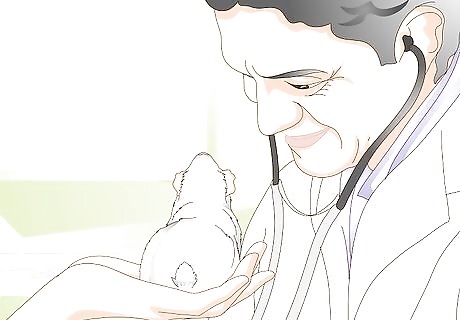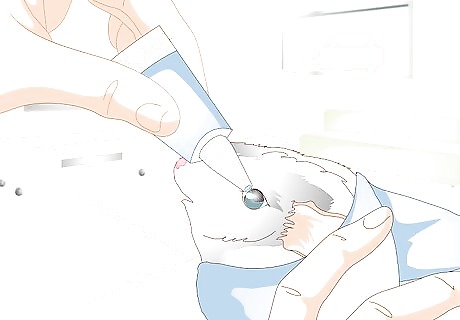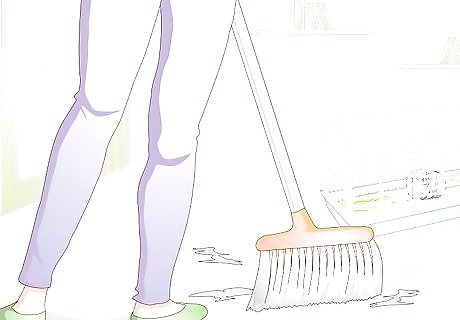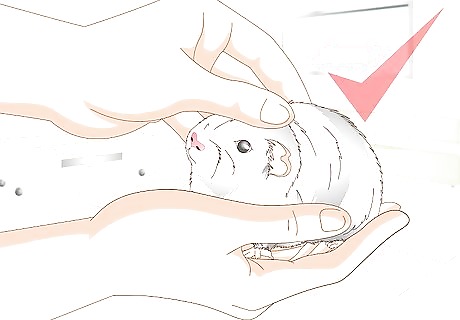
views
X
Research source
Also known as ‘pink eye’ or ‘red-eye,’[2]
X
Research source
conjunctivitis can feel very irritating to your guinea pig. Treating this condition and preventing it from happening again will help your guinea pig recover and have more fun in his environment.
Treating Conjunctivitis in Your Guinea Pig

Recognize the clinical signs of conjunctivitis. If your guinea pig’s eyelids look pink or red around the edges, you can be pretty sure that he has conjunctivitis. You may also see different types of discharge coming from the eye: thick and yellow (indicates infection) or clear and watery. The entirety of the infected eye will look swollen and inflamed. Because of the irritation, your guinea pig will scratch his eyes, which makes conjunctivitis worse. Your guinea pig’s eyelids might also be sticky due to the buildup of dried discharge. You may notice hair missing under your guinea pig’s lower eyelids. If something got in your guinea pig’s eyes and blocked the tear ducts, the tear fluid would end up constantly spilling onto the lower eyelid. The hair would fall out because of the constant wetness. Since guinea pigs like to root around in their bedding, your guinea pig may have gotten some bedding stuck in his eye that has caused inflammation and irritation. It probably wouldn’t be too hard to see bedding in his eye.

Take your guinea pig to the veterinarian. You may be tempted to go to your local pet store, find some eye drops or eye ointment, and treat your guinea pig yourself. This is not a good idea, though—guinea pigs can be very sensitive to eye medications and develop allergic reactions to them. Go see your veterinarian first before doing any at-home treatments. If your guinea pig has something stuck in his eye, do not remove it! This will do more harm than good. Your veterinarian will be able to remove the object safely. Conjunctivitis is most commonly caused by a bacteria (e.g., Bordatella, Streptococcus, Chlamydia). Only your veterinarian will be able to identify which bacteria is causing the conjunctivitis. Your veterinarian will diagnose conjunctivitis by looking at the eyes and taking a sample of the discharge to identify which bacteria are causing the condition.

Follow treatment instructions. When your veterinarian has diagnosed conjunctivitis, he or she will prescribe an antibiotic eye ointment or eye drop. Your guinea pig will also need an antiseptic eyewash for cleaning the eyes. To treat your guinea pig’s eyes, wrap him snugly in a towel to restrain him and give him the medications as instructed by your veterinarian. Have a soft, clean towel nearby to gently dry your guinea pig’s eyes after you clean and treat them. Even if your guinea pig’s eyes start to look better, continue to treat them according to your veterinarian’s instructions. Stopping the treatment too soon may not kill all of the bacteria, leaving your guinea pig susceptible to getting sick again. If you are unsure about how to treat your guinea pig’s eyes, have your veterinarian demonstrate the proper technique before you leave the veterinary office. You may need to treat your guinea pig’s conjunctivitis for up to a few weeks.

Schedule follow-up appointments. Your veterinarian will want to see your guinea pig at least once after the initial treatment to check his eyes. If your guinea pig’s eyes still look irritated, or there is still discharge coming from the eyes, your veterinarian will probably want you to keep treating the eyes at home. You may need to schedule several follow-up appointments to ensure your guinea pig’s conjunctivitis has been completely treated.
Preventing Conjunctivitis in Your Guinea Pig

Select dust-free bedding. Because guinea pigs like to root around in their bedding, they can get pieces of bedding or specks of dust in their eyes, both of which can irritate. Examples of dust-free bedding are Carefresh, newspaper, and shredded paper. Newspaper and shredded paper are not very absorbent and do not control odor. If you want to use paper bedding, you will need to use it along with more absorbent bedding that also controls odor. Polar fleece is also dust-free and is becoming more popular as a bedding choice. Although it is good at wicking away urine, it should be used along with more absorbent bedding, such as towels. Fleece bedding needs to be washed several times before use. Do not use sawdust since it is very dusty. Some wood shavings are low in dust, but the wood specks could get stuck in your guinea pig’s eyes.

Keep your house clean. The cleaner your house, the lower the levels of bacteria in your home that could cause your guinea pig to develop conjunctivitis. Also, regularly dusting your home could lessen the chances of dust getting in your guinea pig’s eyes. It may help to have a regular schedule of cleaning to make you don’t miss anything.

Reduce your guinea pig’s stress levels. In general, stress can weaken your guinea pig’s immune system and increase his risk of getting sick. Sudden changes to his routine, such as diet and playtime, can make your guinea pig feel stressed. Also, if you don’t hold him as much as you used to, or don’t hold him at the same time every day, he might feel stressed. Other than illness, signs of stress include depression, decreased activity, and possibly aggression. If you notice that sudden changes to his daily routine are stressing out your guinea pig, make the changes more slowly. Whatever the cause of stress, try to identify it and remove and/or change it.




















Comments
0 comment